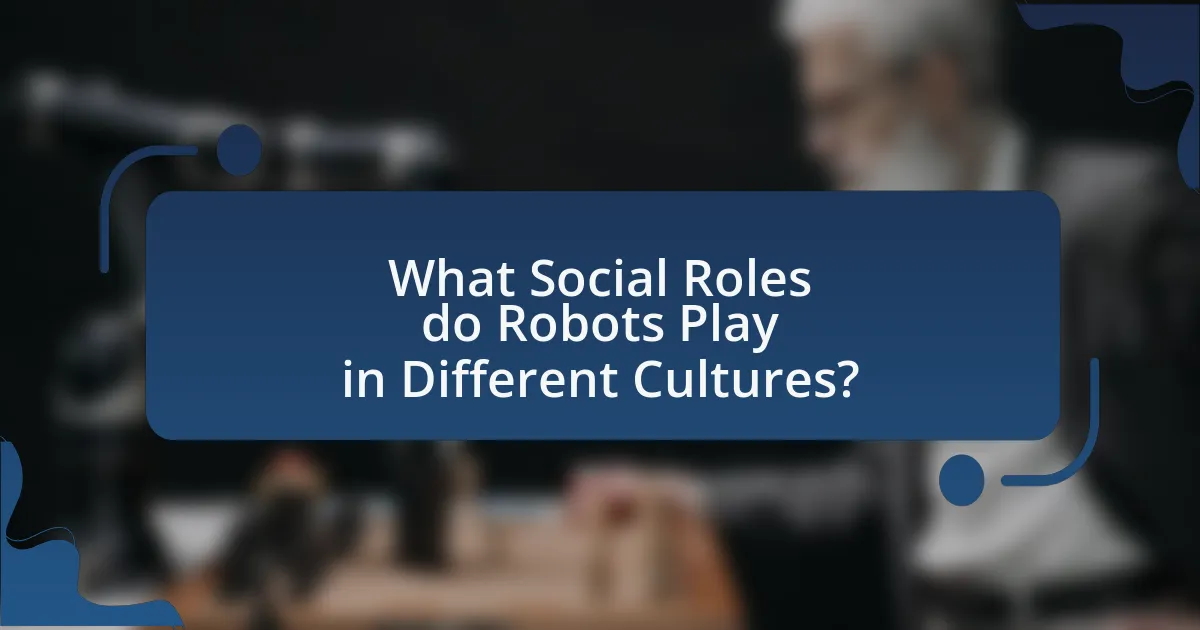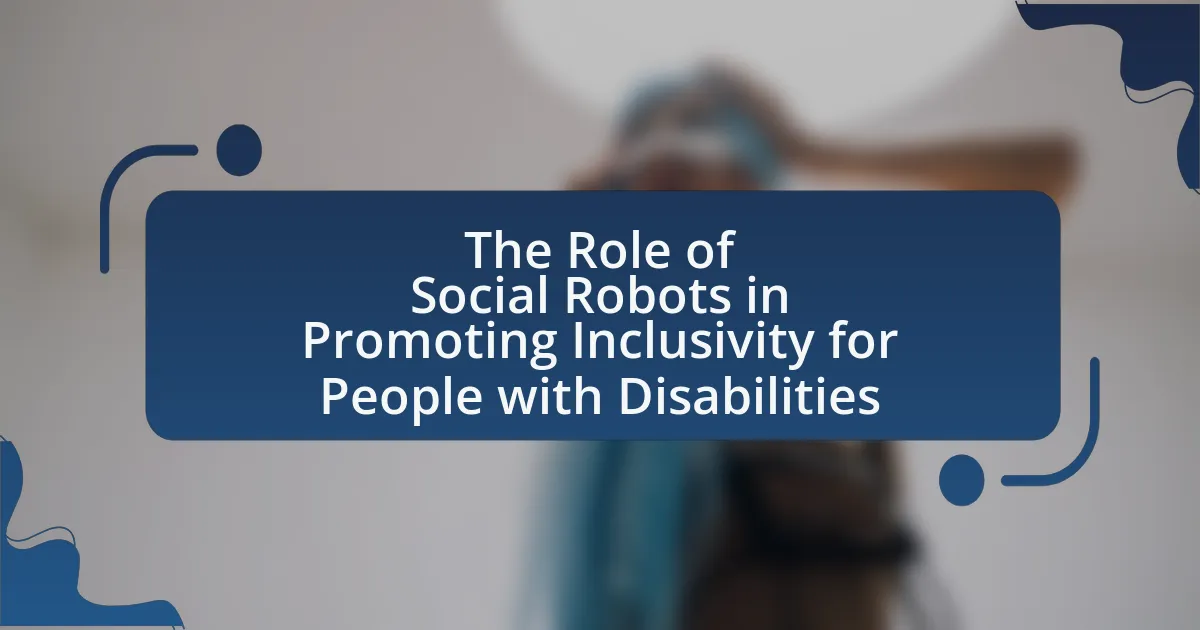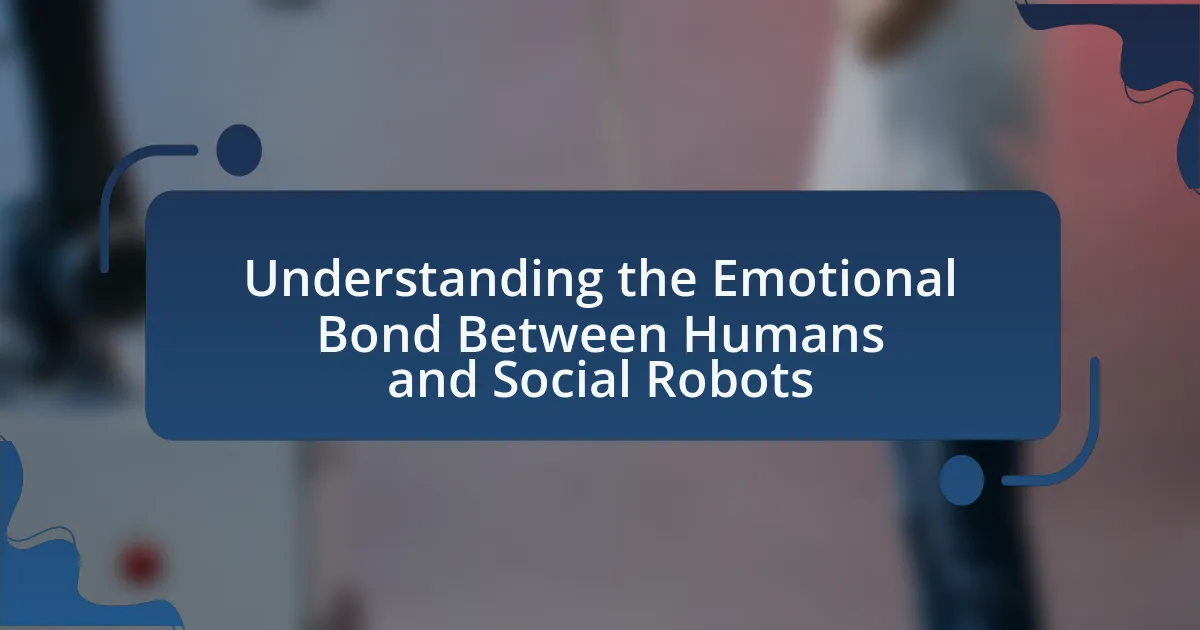Cultural perceptions of robots significantly influence their acceptance and integration into society, varying across different cultures due to historical, social, and technological contexts. In Japan, robots are often embraced as companions and helpers, reflecting a cultural affinity for technology, while Western cultures frequently view them with skepticism, focusing on concerns about job displacement and ethical implications. This article explores how cultural narratives shape the image of robots, the roles they play in various societies, and the implications of these perceptions on robot design, functionality, and user acceptance. Additionally, it examines the impact of media and literature on public attitudes towards robots and the ethical considerations that arise from these cultural perceptions.

What are Cultural Perceptions of Robots?
Cultural perceptions of robots vary significantly across different societies, influenced by historical, social, and technological contexts. In Japan, for example, robots are often viewed positively, seen as companions and helpers, largely due to cultural narratives that embrace technology, such as the concept of “kawaii” (cuteness) associated with humanoid robots. Conversely, in Western cultures, robots may evoke fear or skepticism, often depicted in media as threats to employment or humanity, as seen in films like “The Terminator” and “I, Robot.” These contrasting views highlight how cultural narratives shape the acceptance and integration of robots into daily life, with studies indicating that familiarity and positive media representation can enhance acceptance.
How do different cultures view robots?
Different cultures view robots through varied lenses shaped by historical, social, and technological contexts. For instance, in Japan, robots are often seen as companions and helpers, reflecting the cultural value placed on harmony and assistance, as evidenced by the widespread acceptance of humanoid robots like ASIMO and social robots like Pepper. In contrast, many Western cultures, particularly in the United States, tend to view robots with skepticism, focusing on concerns about job displacement and ethical implications, as highlighted by surveys indicating that a significant portion of the population fears automation will lead to unemployment. Additionally, in some cultures, robots are perceived as tools for efficiency and productivity, while in others, they may evoke fears of dehumanization or loss of control. These differing perspectives illustrate how cultural values and societal norms influence the acceptance and integration of robotic technology.
What historical factors influence these perceptions?
Historical factors that influence perceptions of robots include advancements in technology, cultural narratives, and significant events in industrialization. The Industrial Revolution marked a pivotal shift, introducing machines that transformed labor and societal roles, leading to both admiration and fear of automation. Additionally, science fiction literature and films, such as Isaac Asimov’s “I, Robot,” shaped public imagination about robots, often portraying them as either helpers or threats. Furthermore, historical events like the rise of artificial intelligence in the late 20th century have contributed to evolving perceptions, as society grapples with the implications of intelligent machines on employment and ethics. These factors collectively inform contemporary views on robots and their roles in society.
How do cultural narratives shape the image of robots?
Cultural narratives significantly shape the image of robots by influencing public perception and expectations regarding their capabilities and roles. For instance, in Western media, robots are often depicted as either helpful assistants or potential threats, as seen in films like “I, Robot” and “Ex Machina,” which create a dichotomy between benevolence and malevolence. This portrayal affects societal attitudes, leading to a mix of fascination and fear towards robotic technology. Furthermore, cultural narratives in Japan, such as the concept of “karakuri” (mechanical dolls), promote a more positive view of robots as companions and helpers, which fosters acceptance and integration of robotics in daily life. These contrasting narratives illustrate how cultural contexts can dictate the emotional and ethical frameworks through which robots are understood, ultimately shaping their acceptance and integration into society.
Why are cultural perceptions important in robotics?
Cultural perceptions are important in robotics because they influence how individuals and societies interact with and accept robotic technologies. These perceptions shape user expectations, trust levels, and the overall integration of robots into daily life. For instance, research indicates that in cultures with a high acceptance of technology, such as Japan, robots are often viewed positively and integrated into various sectors, including healthcare and entertainment. Conversely, in cultures with skepticism towards technology, such as some Western societies, there may be resistance to adopting robots, impacting their development and deployment. Understanding these cultural nuances is essential for designing robots that resonate with users and fulfill their intended social roles effectively.
How do perceptions affect robot design and functionality?
Perceptions significantly influence robot design and functionality by shaping user expectations and acceptance. For instance, cultural attitudes towards robots can dictate aesthetic choices, such as whether a robot appears humanoid or mechanical, which in turn affects user interaction and trust. Research indicates that robots designed to align with cultural norms and values are more likely to be embraced by users, as seen in studies where robots mimicking local customs and behaviors received higher acceptance rates. This correlation underscores the importance of integrating cultural perceptions into the design process to enhance functionality and user experience.
What role do media and literature play in shaping perceptions?
Media and literature significantly shape perceptions by influencing societal narratives and cultural understandings. Through various forms of storytelling, media and literature create frameworks that inform how individuals view concepts, including technology and robots. For instance, films like “Blade Runner” and books such as Isaac Asimov’s “I, Robot” have established archetypes and ethical dilemmas surrounding artificial intelligence, thereby affecting public attitudes toward robots. Research indicates that exposure to these narratives can alter perceptions, as seen in studies showing that positive portrayals of robots in media lead to increased acceptance and trust in robotic technologies.
What are the implications of cultural perceptions on society?
Cultural perceptions significantly shape societal norms, values, and behaviors. These perceptions influence how individuals and groups interact with one another, affecting social cohesion and community dynamics. For instance, research indicates that cultures with a high regard for technology often embrace robots in various roles, leading to increased acceptance of automation in daily life (Source: “Cultural Attitudes Toward Robots: A Cross-Cultural Study,” authors: K. D. Lee and M. A. Kwon). Conversely, cultures that view robots with skepticism may resist technological integration, impacting economic development and innovation. Thus, cultural perceptions directly affect societal progress and the acceptance of new technologies.
How do perceptions influence public acceptance of robots?
Perceptions significantly influence public acceptance of robots by shaping attitudes and beliefs about their capabilities and roles in society. Positive perceptions, such as viewing robots as helpful and trustworthy, lead to greater acceptance and integration into daily life, as evidenced by studies showing that familiarity with robots increases comfort levels and willingness to interact with them. Conversely, negative perceptions, often fueled by fears of job displacement or loss of control, can result in resistance to robotic technologies. Research indicates that cultural context plays a crucial role; for instance, societies with a history of technological adoption tend to exhibit more favorable attitudes towards robots, while cultures emphasizing human labor may show skepticism.
What ethical considerations arise from these perceptions?
Ethical considerations arising from cultural perceptions of robots and their social roles include issues of autonomy, responsibility, and the potential for bias. These perceptions can lead to the dehumanization of individuals who interact with robots, as people may attribute human-like qualities to machines, impacting their moral and ethical decision-making. For instance, research indicates that when robots are perceived as companions, users may develop emotional attachments, raising questions about consent and emotional manipulation. Additionally, biases in programming and design can perpetuate stereotypes, as seen in studies where robots reflect societal prejudices, thus reinforcing discriminatory practices. These ethical dilemmas necessitate careful consideration in the development and deployment of robotic technologies to ensure they align with societal values and promote equitable interactions.

What Social Roles do Robots Play in Different Cultures?
Robots play diverse social roles across different cultures, often reflecting societal values and technological acceptance. In Japan, robots are integrated into daily life as companions and helpers, exemplified by the popularity of humanoid robots like Pepper, which serve emotional and social functions. In contrast, Western cultures often view robots primarily as tools for efficiency and productivity, focusing on automation in industries rather than social interaction. Research by the Pew Research Center indicates that cultural attitudes towards robots significantly influence their acceptance and integration, with societies that prioritize innovation and technology more likely to embrace robots in social roles.
How are robots integrated into daily life across cultures?
Robots are integrated into daily life across cultures through various applications such as healthcare, manufacturing, and domestic assistance. In Japan, for instance, robots like ASIMO are used in elder care facilities to assist with mobility and companionship, reflecting the cultural emphasis on respect for the elderly. In contrast, in the United States, robots are increasingly utilized in manufacturing settings, with statistics indicating that over 250,000 industrial robots were in operation by 2020, enhancing productivity and safety. Additionally, in European countries, robots are employed in household tasks, with a survey showing that 20% of households in Sweden own a robotic vacuum cleaner, illustrating a growing acceptance of robots in personal spaces. These examples demonstrate how cultural values and economic needs shape the integration of robots into everyday life.
What roles do robots serve in household settings?
Robots serve various roles in household settings, primarily focusing on tasks such as cleaning, cooking, and companionship. For instance, robotic vacuum cleaners automate floor cleaning, significantly reducing the time and effort required by homeowners. According to a study by the International Federation of Robotics, the global market for household robots, including vacuum cleaners and lawn mowers, reached approximately 12 million units sold in 2020, indicating a growing reliance on these devices for everyday chores. Additionally, social robots, like those designed for companionship, provide emotional support and interaction, addressing loneliness, particularly among the elderly. This multifaceted functionality highlights the increasing integration of robots into daily domestic life, reflecting cultural shifts towards automation and technology in personal spaces.
How do robots function in professional environments?
Robots function in professional environments by automating tasks, enhancing efficiency, and improving accuracy in various industries. In manufacturing, for example, robots are utilized for assembly line work, performing repetitive tasks with precision that reduces human error and increases production rates. According to a report by the International Federation of Robotics, the global stock of operational industrial robots reached 2.7 million units in 2020, demonstrating their widespread adoption in sectors such as automotive and electronics. Additionally, in healthcare, robots assist in surgeries and patient care, providing support that enhances the capabilities of medical professionals. This integration of robots into professional settings not only streamlines operations but also reshapes workforce dynamics, leading to new roles and responsibilities for human workers.
What are the cultural differences in robot roles?
Cultural differences in robot roles manifest in how societies perceive and integrate robots into daily life. For instance, in Japan, robots are often viewed as companions and helpers, reflecting a cultural affinity for technology and a belief in the potential for robots to enhance human relationships. This is evidenced by the widespread acceptance of robots like Aibo, a robotic dog, which symbolizes companionship and emotional connection. In contrast, in Western cultures, particularly in the United States, robots are frequently seen as tools for efficiency and productivity, emphasizing their utility in industries such as manufacturing and logistics. This perspective is supported by the significant investment in automation technologies aimed at improving operational efficiency. These differing cultural attitudes shape the roles that robots play, influencing their design, functionality, and acceptance in various societies.
How do robots serve different purposes in Eastern vs. Western cultures?
Robots serve different purposes in Eastern and Western cultures primarily due to varying cultural values and societal needs. In Eastern cultures, such as Japan, robots are often integrated into daily life as companions and helpers, reflecting a collectivist mindset that values harmony and social interaction; for instance, Japan has developed humanoid robots like ASIMO and social robots like Pepper to assist in caregiving and customer service roles. In contrast, Western cultures, particularly in the United States, tend to focus on robots as tools for efficiency and productivity, emphasizing individualism and innovation; examples include industrial robots in manufacturing and automation technologies that enhance productivity in various sectors. This divergence illustrates how cultural perceptions shape the roles and functionalities of robots in society.
What unique roles do robots play in specific cultural contexts?
Robots serve unique roles in various cultural contexts, often reflecting the values and needs of those societies. In Japan, for instance, robots are integrated into daily life as companions and caregivers, influenced by the cultural emphasis on harmony and respect for the elderly. This is exemplified by the development of robots like Paro, a therapeutic seal robot designed to provide comfort to dementia patients, which aligns with Japan’s aging population and societal norms around caregiving. In contrast, in Western cultures, robots often take on roles in industrial automation and efficiency, reflecting values of productivity and innovation. For example, the widespread use of industrial robots in manufacturing sectors in the United States highlights a focus on economic growth and technological advancement. These cultural contexts shape how robots are perceived and utilized, demonstrating that their roles are not merely functional but deeply intertwined with societal values and expectations.
What future roles might robots assume in society?
Robots may assume various roles in society, including healthcare assistants, autonomous vehicles, and personal companions. In healthcare, robots can assist with surgeries, monitor patients, and provide rehabilitation support, enhancing efficiency and precision in medical procedures. Autonomous vehicles are expected to revolutionize transportation, reducing accidents and improving traffic flow through advanced navigation systems. Additionally, personal companion robots can offer emotional support and companionship, particularly for the elderly, addressing social isolation. These roles are supported by advancements in artificial intelligence and robotics, which have shown significant improvements in task execution and human interaction capabilities.
How might cultural perceptions evolve with technological advancements?
Cultural perceptions may evolve significantly with technological advancements, particularly as robots and artificial intelligence become more integrated into daily life. As technology improves, societies often adapt their views on the roles and capabilities of robots, shifting from skepticism to acceptance. For instance, a study by the Pew Research Center in 2017 found that 72% of Americans believe that robots will take over many jobs, indicating a growing recognition of robots’ potential impact on the workforce. This shift in perception can lead to increased trust in robots, as seen in countries like Japan, where robots are often viewed as companions and helpers rather than threats. Such changes in cultural attitudes reflect a broader trend of embracing technology, which can enhance social roles and redefine human-robot interactions.
What potential new roles could robots take on in various cultures?
Robots could take on roles such as caregivers, educators, and cultural ambassadors in various cultures. In caregiving, robots can assist the elderly or disabled, providing companionship and support, which is particularly relevant in aging societies like Japan, where over 28% of the population is aged 65 or older. In education, robots can serve as teaching assistants, enhancing learning experiences through interactive technology, as seen in countries like South Korea, where educational robots are integrated into classrooms to promote STEM learning. Additionally, robots can act as cultural ambassadors, helping to preserve and promote local traditions and languages, which is crucial in multicultural societies where cultural heritage is at risk. These roles reflect the adaptability of robots to meet the specific needs and values of different cultures, demonstrating their potential to enhance social cohesion and support community well-being.

How do Cultural Perceptions Affect the Development of Robots?
Cultural perceptions significantly influence the development of robots by shaping design choices, functionalities, and societal acceptance. For instance, in Japan, where robots are often viewed as companions, developers create humanoid robots with emotional intelligence and social interaction capabilities, as seen in the development of robots like ASIMO and Pepper. Conversely, in Western cultures, robots are frequently perceived as tools for efficiency and productivity, leading to a focus on industrial applications and automation, exemplified by the widespread use of robotic arms in manufacturing. These cultural attitudes directly impact funding, research priorities, and the ethical considerations surrounding robotics, as evidenced by varying regulations and public discourse on AI and robotics in different regions.
What design considerations arise from cultural perceptions?
Design considerations arising from cultural perceptions include the need for sensitivity to local customs, values, and aesthetics. Different cultures may have varying interpretations of functionality, appearance, and interaction styles, which can significantly influence user acceptance and usability of designs. For instance, in some cultures, robots designed for caregiving may need to exhibit more human-like features to be perceived as trustworthy, while in others, a more mechanical appearance may be preferred. Research indicates that cultural context shapes user expectations and emotional responses, highlighting the importance of incorporating cultural insights into the design process to enhance user experience and acceptance.
How do user preferences shape robot aesthetics?
User preferences significantly shape robot aesthetics by influencing design choices that align with cultural expectations and emotional responses. For instance, research indicates that users often prefer robots that exhibit human-like features, such as facial expressions and body language, as these traits foster a sense of familiarity and trust. A study published in the journal “Robotics and Autonomous Systems” by F. D. R. de Graaf and A. A. M. Allouch found that robots designed with more anthropomorphic characteristics were perceived as more approachable and friendly, which directly impacts user acceptance and interaction. Thus, user preferences drive designers to create robots that resonate with societal norms and emotional needs, ultimately shaping the visual and functional aspects of robotic aesthetics.
What functionalities are prioritized based on cultural needs?
Functionalities prioritized based on cultural needs include adaptability to local customs, language support, and social interaction capabilities. These functionalities ensure that robots can effectively integrate into diverse cultural contexts, enhancing user acceptance and usability. For instance, research indicates that robots designed for specific cultural environments, such as caregiving robots in Japan, emphasize companionship and emotional support, reflecting the cultural value placed on social harmony and elder care. This alignment with cultural expectations fosters trust and promotes the successful adoption of robotic technologies.
How do cultural perceptions influence robot interaction styles?
Cultural perceptions significantly influence robot interaction styles by shaping user expectations and behaviors towards robots. For instance, in cultures that value collectivism, such as Japan, robots are often designed to facilitate group harmony and cooperation, leading to more collaborative interaction styles. Conversely, in individualistic cultures like the United States, robots may be perceived as tools for personal efficiency, resulting in more task-oriented interactions. Research by K. K. K. Lee and colleagues in “Cultural Differences in Human-Robot Interaction” (2018) highlights that these cultural frameworks dictate how users interpret robot actions and responses, ultimately affecting their willingness to engage with robotic systems.
What communication methods are preferred in different cultures?
Different cultures prefer various communication methods, influenced by their social norms and values. For instance, in high-context cultures like Japan and China, non-verbal cues and implicit messages are emphasized, leading to a preference for indirect communication. Conversely, low-context cultures such as the United States and Germany favor direct and explicit communication, valuing clarity and straightforwardness. Research by Edward T. Hall highlights these distinctions, noting that high-context cultures rely on shared experiences and relationships to convey meaning, while low-context cultures prioritize verbal expression. This cultural variation in communication methods significantly impacts interpersonal interactions and the integration of technology, including robots, into social roles.
How do cultural norms dictate robot behavior and responses?
Cultural norms dictate robot behavior and responses by shaping the expectations and interactions humans have with robots in various societies. For instance, in cultures that value collectivism, robots may be programmed to prioritize group harmony and cooperation, reflecting social values that emphasize community over individuality. Conversely, in individualistic cultures, robots might be designed to support personal autonomy and self-expression, aligning with societal norms that celebrate independence. Research indicates that these cultural frameworks influence not only the design of robots but also the acceptance and trust users place in them, as seen in studies like “Cultural Differences in Human-Robot Interaction” by K. K. Lee and M. A. K. Kwon, which highlights how cultural context affects user expectations and robot functionality.
What best practices should developers follow to align with cultural perceptions?
Developers should prioritize user-centered design, cultural sensitivity, and inclusive testing to align with cultural perceptions. User-centered design ensures that products meet the specific needs and preferences of diverse cultural groups, enhancing usability and acceptance. Cultural sensitivity involves understanding and respecting cultural norms, values, and practices, which can significantly influence how technology is perceived and utilized. Inclusive testing, which includes participants from various cultural backgrounds, helps identify potential biases and ensures that the technology resonates positively across different demographics. These practices are supported by research indicating that culturally aware design leads to higher user satisfaction and engagement, as seen in studies like “Cultural Dimensions in Human-Computer Interaction” by Marcus and Gould, which highlights the importance of cultural context in technology adoption.
How can developers ensure cultural sensitivity in robot design?
Developers can ensure cultural sensitivity in robot design by conducting thorough research on the cultural norms, values, and practices of the target user demographic. This involves engaging with diverse communities to gather insights and feedback, which can inform design choices that respect and reflect cultural identities. For instance, a study by the University of Southern California highlighted that robots designed for elder care in Japan must incorporate elements of respect and familial connection, which are crucial in Japanese culture. By integrating such culturally relevant features, developers can create robots that are not only functional but also socially acceptable and meaningful within specific cultural contexts.
What strategies can enhance user acceptance of robots in diverse cultures?
To enhance user acceptance of robots in diverse cultures, strategies should focus on cultural customization, education, and user involvement. Cultural customization involves adapting robots’ design, functionality, and interaction styles to align with local customs and values, which has been shown to increase relatability and acceptance. For instance, research indicates that robots designed with culturally relevant aesthetics and behaviors are more readily accepted in specific cultural contexts. Education plays a crucial role by informing users about the benefits and functionalities of robots, thereby reducing fear and misconceptions. Studies have demonstrated that informed users are more likely to embrace robotic technology. Lastly, involving users in the design and development process fosters a sense of ownership and trust, leading to higher acceptance rates. Engaging communities in co-creation initiatives has been proven to enhance user satisfaction and acceptance across various cultural settings.





